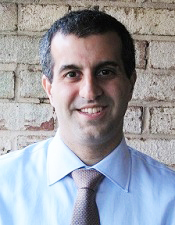 New Computer Science Lecturer, Pedram Sadeghian, always knew that teaching was for him. It was figuring out what to teach that was the challenge.
New Computer Science Lecturer, Pedram Sadeghian, always knew that teaching was for him. It was figuring out what to teach that was the challenge.
Dr. Sadhegian studied Psychology as an undergraduate. It wasn’t until after college, when—out of curiosity—he took a class in C programming, that he fell in love with the subject. “I liked the whole concept of problem solving and algorithm development,” says Dr. Sadeghian. “It is a fun challenge to get a program to run and produce the correct output.”
He got his Master’s in Computer Science and his Ph.D. in Computer Science and Engineering from the University of Louisville. After graduating in 2006, Dr. Sadhegian dove right into a career in teaching.
“It never gets boring,” he says. As a teacher, he is always learning something new. Dr. Sadeghian taught briefly in Kentucky until a position at Howard Community College (HCC) lured him to Maryland in 2007. For six years, he coordinated and taught classes in HCC’s Computer Science and Information Systems program.
The biggest difference between HCC and UMBC?
“Parking,” he laughs. But, also class size. This semester, Dr. Sadeghian has a whopping 190 students—even a few former HCC students—in his two classes. He is teaching CMSC 104: Problem Solving and Computer Programming, a non-major course that ex-plores fundamental problem solving and algorithm development, and CMSC 201: Computer Science I, an introductory computer programming class for majors. For most students, these classes are their very first encounter with Computer Science.
For Dr. Sadeghian, that’s what makes them his favorite classes to teach. He enjoys the responsibility of opening young minds to the field, and ultimately, future careers, in Computer Science. To do that, Dr. Sadeghian knows that he must engage his students.
“I really like to make the class session interactive and dynamic,” he says. Dr. Sadeghian demonstrates programming concepts on the computer, rather than stuffing them into slides. He gives live demos, knowing that even when mistakes happen, students are engaged and learning better.
His goal is to be the best teacher that he can be.
“The qualities of a good teacher are that they are interested in the subject, are prepared for their lecture, explain concepts clearly, give meaningful examples and assignments, and are ready to address questions both in the classroom and during office hours,” he says. “I try to demonstrate these qualities in my courses.”